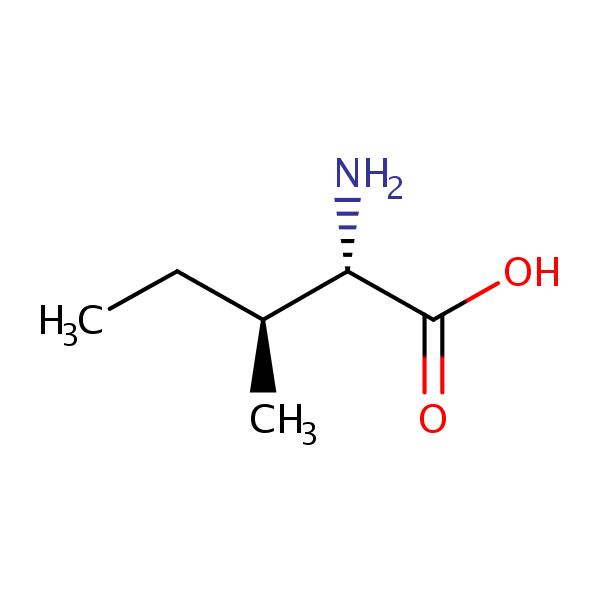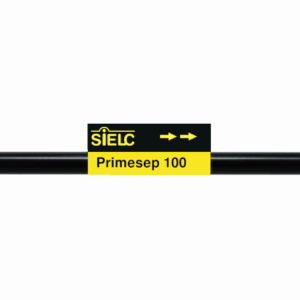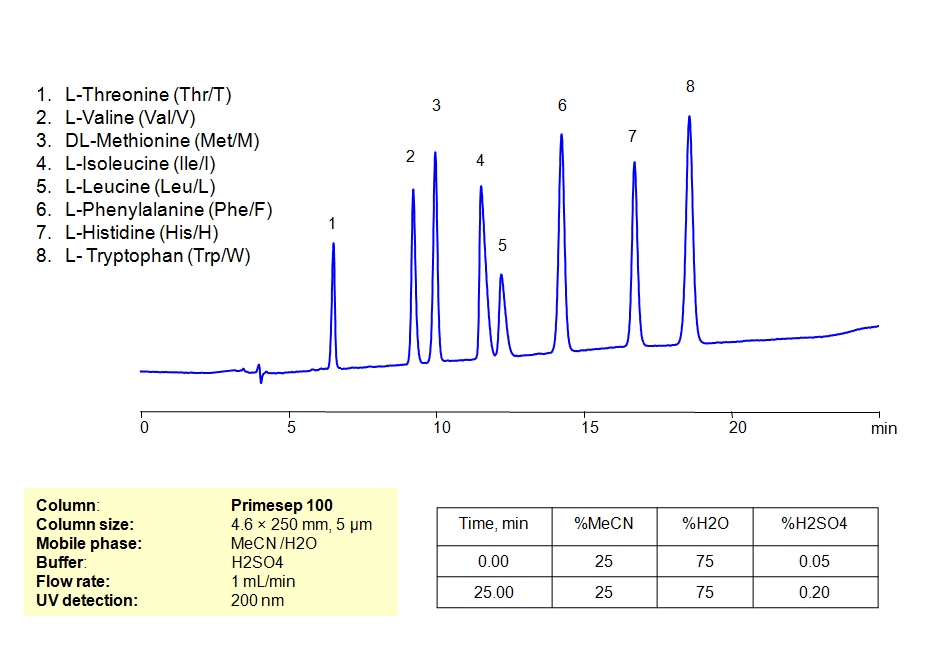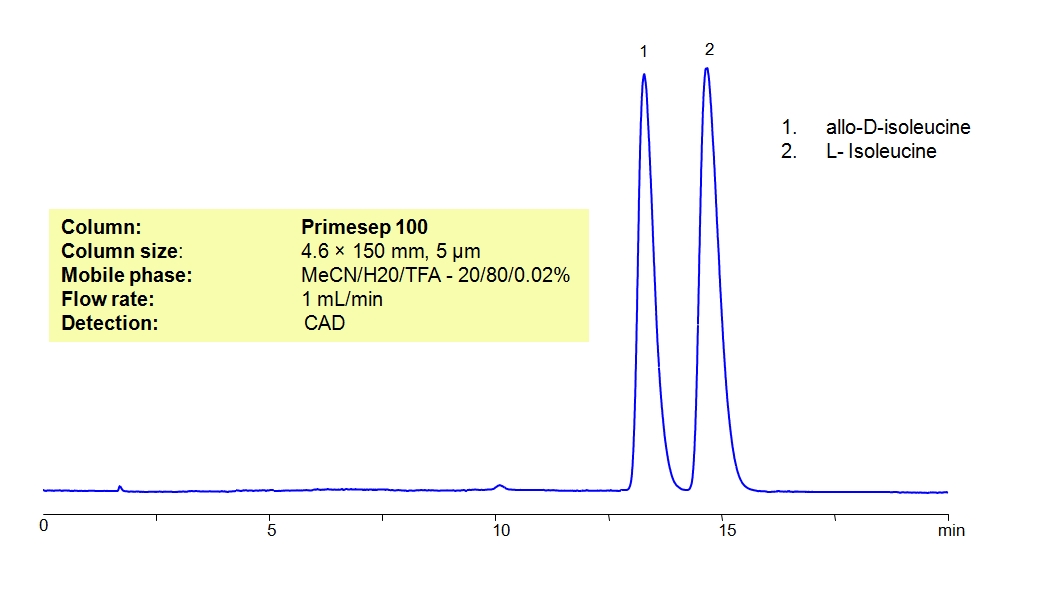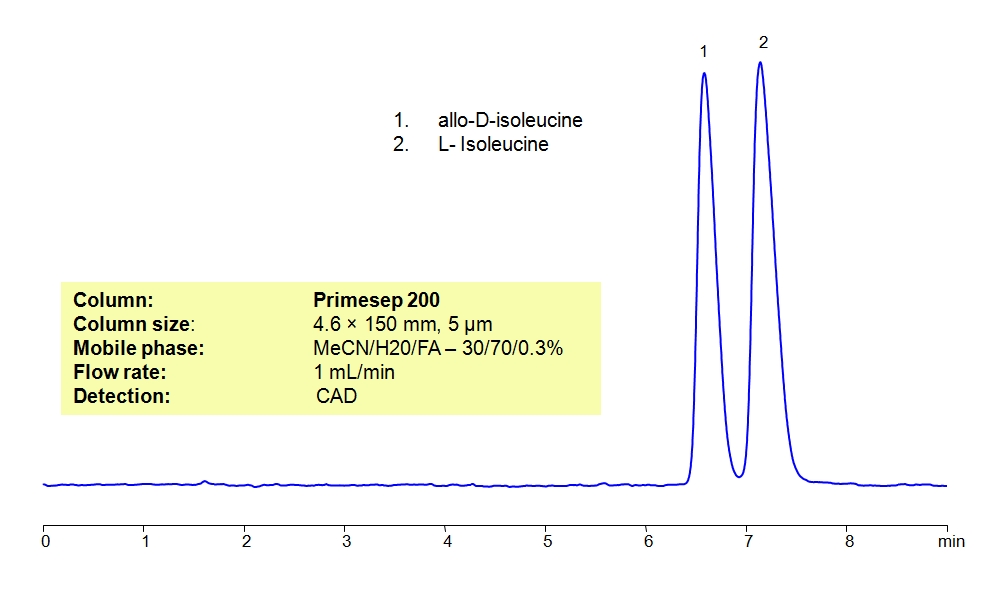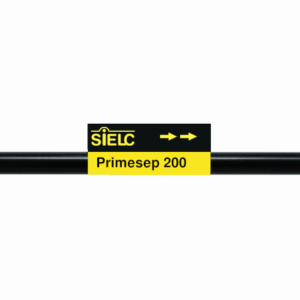| CAS Number | 73-32-5 |
|---|---|
| Molecular Formula | C6H13NO2 |
| Molecular Weight | 131.175 |
| InChI Key | AGPKZVBTJJNPAG-WHFBIAKZSA-N |
| LogP | -0.720 |
| Synonyms |
|
Applications:
HPLC Separation of Allo-Isoleucine, Isoleucine, Leucine on Primesep 100 Column
November 12, 2019
HPLC Method for D-Isoleucine, D-Leucine, DL-Isoleucine, L-Alloisoleucine, L-Isoleucine, allo-D-isoleucine, Isoleucine, Leucine on Primesep 100 by SIELC Technologies
High Performance Liquid Chromatography (HPLC) Method for Analysis of D-Isoleucine, D-Leucine, DL-Isoleucine, L-Alloisoleucine, L-Isoleucine, allo-D-isoleucine, Isoleucine, Leucine
Alloisoleucine is an amino acid with C6H13NO2 chemical formula. It is a key indicator when diagnosing Maple Syrup Urine Disease, when a body cannot metabolize amino acids in specific foods. Outside of that, it is also used in peptide synthesis and drug development.
Isoleucine is an amino acid with chemical formula C6H13NO2. It is a building block for proteins and is used in a variety of bodily functions. It helps form hemoglobin, regulating blood sugar, plays a key role in energy production, and increases the speed of muscle healing and growth. The easiest way to prevent a deficiency of it is through eating foods rich in protein, as those typically contain necessary amino acids.
Leucine is an amino acid with chemical formula C6H13NO2. It is key for protein synthesis, metabolism, tissue repair, and certain tasks that are also done by Isoleucine. It is known to activate mTOR cell signalng pathways, which stimulate protein synthesis and prevent breakdown of protein. It is found bin animal protein, plant-based protein, and nuts.
D-Isoleucine, D-Leucine, DL-Isoleucine, L-Alloisoleucine, L-Isoleucine, allo-D-isoleucine, Isoleucine, Leucine can be retained and analyzed using the Primesep 100 stationary phase column. The analysis utilizes an isocratic method with a simple mobile phase consisting of water and acetonitrile (MeCN) with a ammonium formate buffer. Detection is performed using CAD.
| Column | Primesep 100, 4.6 x 250 mm, 5 µm, 100 A, dual ended |
| Mobile Phase | MeCN/H2O – 5/95% |
| Buffer | AmFM pH 3.0 – 30 mM |
| Flow Rate | 1.0 ml/min |
| Detection | CAD (Corona) MS- compatible mobile phase |
| Class of Compounds |
Drug, Acid, Hydrophilic, Ionizable, Vitamin, Supplements, Amino acid |
| Analyzing Compounds | D-Isoleucine, D-Leucine, DL-Isoleucine, L-Alloisoleucine, L-Isoleucine, allo-D-isoleucine, Isoleucine, Leucine |
Application Column
Primesep 100
Column Diameter: 4.6 mm
Column Length: 250 mm
Particle Size: 5 µm
Pore Size: 100 A
Column options: dual ended
D-Leucine
DL-Isoleucine
Isoleucine
L-Alloisoleucine
L-Isoleucine
Leucine
allo-D-isoleucine

HPLC Separation of Mixture of Essential Amino Acids on Primesep 100 Column
March 11, 2019
HPLC Method for Valine, D-Valine, Methionine, L-Methionine, Isoleucine, D-Isoleucine, DL-Isoleucine, L-Isoleucine, D-Leucine, Phenylalanine, Histidine, L-Histidine hydrochloride monohydrate, Tryptophan, Amino Acids, L-Threonine on Primesep 100 by SIELC Technologies
High Performance Liquid Chromatography (HPLC) Method for Analysis of Valine, D-Valine, Methionine, L-Methionine, Isoleucine, D-Isoleucine, DL-Isoleucine, L-Isoleucine, D-Leucine, Phenylalanine, Histidine, L-Histidine hydrochloride monohydrate, Tryptophan, Amino Acids, L-Threonine.
L-Threonine is an essential amino acid with the chemical formula C4H9NO3. It cannot be produced within the body and must be obtained through consuming it. It’s found in many protein-rich foods, including but not limited to eggs, meat, dairy, legumes, and seeds. It is necessary in the body as a building block of protein like collagen and elastin. The two proteins are crucial for skin, hair, and connective issue.
L-Valine is an essential amino acid with the chemical formula C5H11NO2. It cannot be produced within the body and must be obtained through consuming it. It’s found in foods including but not limited to nuts, legumes, whole grains, and seeds. It is especially beneficial for athletes. It is important for muscle repair, growth, and energy regulation.
DL-Methionine is an essential amino acid with the chemical formula C5H11NO2S. It cannot be produced within the body and must be obtained through consuming it. It is required for protein synthesis. It also helps build and repair tissue including, but not limited to, skin, hair, muscles, and nails. In a veterinary context, DL-Methionine is used to address bladder issues in dogs.
L-Isoleucine is an essential amino acid with the chemical formula C6H13NO2. It cannot be produced within the body and must be obtained through consuming it. It is a building block of protein that are essential for muscle growth, repair, and other bodily functions. It also helps regulate blood sugar levels and supports the immune system. It is found in foods like meat, fish, eggs, dairy, beans, lentils, nuts, and seeds.
L-Leucine is an essential amino acid with the chemical formula C6H13NO2. It cannot be produced within the body and must be obtained through consuming it. It stimulates production of protein that are essential for muscle building and repair. Meats are the easiest way to get L-Leucine in significant amounts.
L-Phenylalanine is an essential amino acid with the chemical formula C6H9NO2. It cannot be produced within the body and must be obtained through consuming it. It is typically found in high protein foods such as meat, eggs, and fish. Outside of being important for creation of protein, it is also used in treatment for skin disorders and depression.
L-Histidine is an essential amino acid with the chemical formula C9H11N3O2. It cannot be produced within the body and must be obtained through consuming it. It s fundamental for repair of damaged tissue, growth of muscles, and making of blood cells. Outside of protein, it also has the unique property of being able to act as a buffer to help maintain stable pH levels in the body. Sources of it include meat, fish, dairy products, beans, and nuts.
L-Tryptophan is an essential amino acid with the chemical formula C11H12N2O2. It cannot be produced within the body and must be obtained through consuming it. Like the other essential proteins, it is a building block for protein and muscle tissue, but it is also converted in the body into serotonin, which affects mood. L-Tryptophan is also used in treatments for severe PMS symptoms, depression, and insomnia. It is naturally found in red meat, poultry eggs, and dairy.
Valine, D-Valine, Methionine, L-Methionine, Isoleucine, D-Isoleucine, DL-Isoleucine, L-Isoleucine, D-Leucine, Phenylalanine, Histidine, L-Histidine hydrochloride monohydrate, Tryptophan, Amino Acids, L-Threonine can be retained and analyzed using the Primesep 100 stationary phase column. The analysis utilizes an isocratic method with a simple mobile phase consisting of water and acetonitrile (MeCN) with a sulfuric acid buffer. Detection is performed using UV.
| Column | Primesep 100, 4.6 x 250 mm, 5 µm, 100 A, dual ended |
| Mobile Phase | MeCN/H2O – 25/75% |
| Buffer | Gradient H2SO4 0.05-0.2% 25 min |
| Flow Rate | 1.0 ml/min |
| Detection | UV, 200 nm |
| Class of Compounds |
Drug, Acid, Hydrophilic, Ionizable, Vitamin, Supplements, Amino acid |
| Analyzing Compounds | Valine, D-Valine, Methionine, L-Methionine, Isoleucine, D-Isoleucine, DL-Isoleucine, L-Isoleucine, D-Leucine, Phenylalanine, Histidine, L-Histidine hydrochloride monohydrate, Tryptophan, Amino Acids, L-Threonine |
Application Column
Primesep 100
Column Diameter: 4.6 mm
Column Length: 250 mm
Particle Size: 5 µm
Pore Size: 100 A
Column options: dual ended
D-Isoleucine
D-Leucine
D-Valine
DL-Isoleucine
Histidine
Isoleucine
L-Histidine hydrochloride monohydrate
L-Isoleucine
L-Methionine
L-Threonine
Methionine
Phenylalanine
Tryptophan
Valine

Separation of allo-D-isoleucine and L- Isoleucine on Primesep 100
March 20, 2018
HPLC Method for Isoleucine, L-Isoleucine, allo-D-isoleucine on Primesep 100 by SIELC Technologies
High Performance Liquid Chromatography (HPLC) Method for Analysis of Isoleucine, L-Isoleucine, allo-D-isoleucine
Allo-D-isoleucine is a non-proteinogenic amino acid with C6H13NO2 molecular formula. It is most commonly used in protein synthesis, neuroprotection, and immune modulation. It is also crucial in synthesis of peptides and can support muscle growth and recovery.
L- Isoleucine is a branched-chain amino acid with C6H13NO2 molecular formula. During chemical reactions, it serves as a nitrogen donor. It is also involved in glucose consumption, fatty acid metabolism, and immune functions. It can be found in a variety of animal and plant products, including meat, eggs, dairy, soybeans, lentils, peas, nuts, and seeds. Healthcare providers may encourage athletes and people with muscle atrophy to take it as a supplement. Excessive consumption of it may lead to side effects including nausea, vomiting, and diarrhea.
Isoleucine, L-Isoleucine, allo-D-isoleucine can be retained and analyzed using the Primesep 100 stationary phase column. The analysis utilizes an isocratic method with a simple mobile phase consisting of water and acetonitrile (MeCN) with a trifluoroacetic acid buffer. Detection is performed using CAD.
| Column | Primesep 100, 4.6×150 mm, 5 µm, 100A |
| Mobile Phase | MeCN/H2O |
| Buffer | TFA, FA |
| Flow Rate | 1.0 ml/min |
| Detection | CAD (Corona) MS- compatible mobile phase |
| Class of Compounds |
Drug, Acid, Hydrophilic, Ionizable, Vitamin, Supplements, Amino acid |
| Analyzing Compounds | Allo-Isoleucine, Isoleucine, Leucine |
Application Column
Primesep 100
Column Diameter: 4.6 mm
Column Length: 150 mm
Particle Size: 5 µm
Pore Size: 100 A
Column options: dual ended
L-Isoleucine
allo-D-isoleucine

Separation of allo-D-isoleucine and L- Isoleucine on Primesep 200
March 20, 2018
HPLC Method for L-Isoleucine, allo-D-isoleucine on Primesep 200 by SIELC Technologies
High Performance Liquid Chromatography (HPLC) Method for Analysis of L-Isoleucine, allo-D-isoleucine
Allo-D-isoleucine is a non-proteinogenic amino acid with C6H13NO2 molecular formula. It is most commonly used in protein synthesis, neuroprotection, and immune modulation. It is also crucial in synthesis of peptides and can support muscle growth and recovery.
L- Isoleucine is a branched-chain amino acid with C6H13NO2 molecular formula. During chemical reactions, it serves as a nitrogen donor. It is also involved in glucose consumption, fatty acid metabolism, and immune functions. It can be found in a variety of animal and plant products, including meat, eggs, dairy, soybeans, lentils, peas, nuts, and seeds. Healthcare providers may encourage athletes and people with muscle atrophy to take it as a supplement. Excessive consumption of it may lead to side effects including nausea, vomiting, and diarrhea.
L-Isoleucine, allo-D-isoleucine can be retained and analyzed using the Primesep 200 stationary phase column. The analysis utilizes an isocratic method with a simple mobile phase consisting of water and acetonitrile (MeCN) with a trifluoroacetic acid buffer. Detection is performed using CAD.
| Column | Primesep 200, 4.6×150 mm, 5 µm, 100A |
| Mobile Phase | MeCN/H2O |
| Buffer | TFA, FA |
| Flow Rate | 1.0 ml/min |
| Detection | CAD (Corona) MS- compatible mobile phase |
| Class of Compounds | Drug, Acid, Hydrophilic, Ionizable, Vitamin, Supplements, Amino acid |
| Analyzing Compounds | Allo-Isoleucine, Isoleucine, Leucine |
Application Column
Primesep 200
Column Diameter: 4.6 mm
Column Length: 150 mm
Particle Size: 5 µm
Pore Size: 100 A
Column options: dual ended
allo-D-isoleucine

